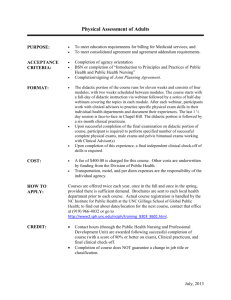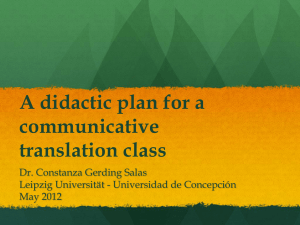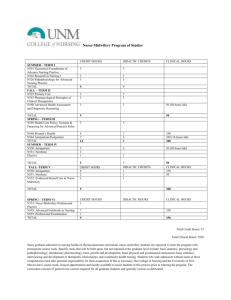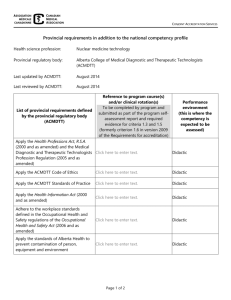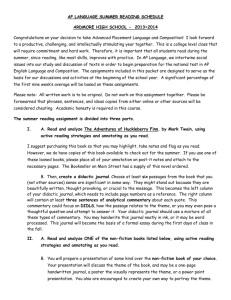workpackage 4 version 02-06-2014 (2)
advertisement
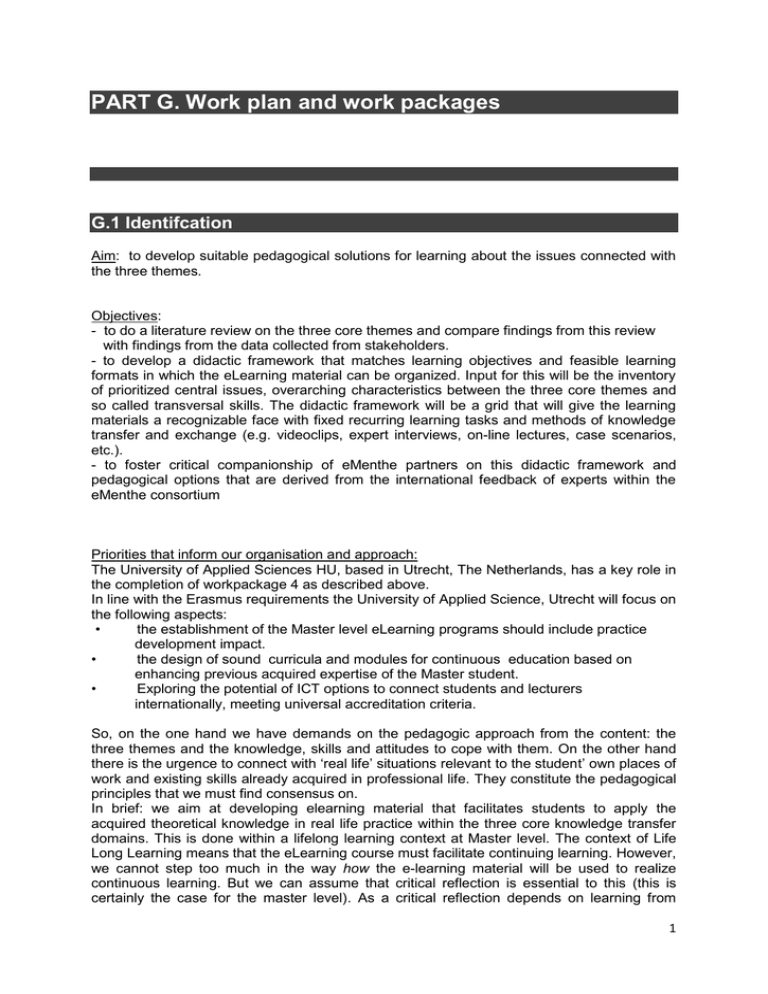
PART G. Work plan and work packages IMPORTANT: Sections G.1 to G.3 should be duplicated and completed together for each work package. G.1 Identifcation Aim: to develop suitable pedagogical solutions for learning about the issues connected with the three themes. Objectives: - to do a literature review on the three core themes and compare findings from this review with findings from the data collected from stakeholders. - to develop a didactic framework that matches learning objectives and feasible learning formats in which the eLearning material can be organized. Input for this will be the inventory of prioritized central issues, overarching characteristics between the three core themes and so called transversal skills. The didactic framework will be a grid that will give the learning materials a recognizable face with fixed recurring learning tasks and methods of knowledge transfer and exchange (e.g. videoclips, expert interviews, on-line lectures, case scenarios, etc.). - to foster critical companionship of eMenthe partners on this didactic framework and pedagogical options that are derived from the international feedback of experts within the eMenthe consortium Priorities that inform our organisation and approach: The University of Applied Sciences HU, based in Utrecht, The Netherlands, has a key role in the completion of workpackage 4 as described above. In line with the Erasmus requirements the University of Applied Science, Utrecht will focus on the following aspects: • the establishment of the Master level eLearning programs should include practice development impact. • the design of sound curricula and modules for continuous education based on enhancing previous acquired expertise of the Master student. • Exploring the potential of ICT options to connect students and lecturers internationally, meeting universal accreditation criteria. So, on the one hand we have demands on the pedagogic approach from the content: the three themes and the knowledge, skills and attitudes to cope with them. On the other hand there is the urgence to connect with ‘real life’ situations relevant to the student’ own places of work and existing skills already acquired in professional life. They constitute the pedagogical principles that we must find consensus on. In brief: we aim at developing elearning material that facilitates students to apply the acquired theoretical knowledge in real life practice within the three core knowledge transfer domains. This is done within a lifelong learning context at Master level. The context of Life Long Learning means that the eLearning course must facilitate continuing learning. However, we cannot step too much in the way how the e-learning material will be used to realize continuous learning. But we can assume that critical reflection is essential to this (this is certainly the case for the master level). As a critical reflection depends on learning from 1 different perspectives, we think that this must be part of the content of the e-learning material. The discussion can further be to what degree ethical issues must be incorporated as these are also an integral part of reflective thinking (again keep in mind that we address the master level). Learning will be done in a so called virtual learning environment (VLE) that facilitates selfpaced learning in an asynchronous training. A VLE has the potency to create and nurture an on-line community of students working independently and with each other. However, the role of an educator functioning as facilitator or tutor is assumed here, but cannot be realized within the terms of the present project. Steps 1 The essential issues (underlying the three themes), overlapping common characteristics and transversal skills that that must be incorporated in the elearning material are identified in the data collected from stakeholders (workpackage 3) and compared with findings from a literature review. Timeplan: may 2014-october 2014. 2 The outcome of this investigation will be the content for cells in a matrix that can serve as input for a didactic framework. Timeplan: october 2014. The outcome of the literature review can be the input for the first of two articles (for each of the three core themes) to be submitted to professional journals. The second article will then focus on the outcome of the matching of findings from our data with literature. Timeplan: first draft of the manuscript: November 2014. 3 Prioritising content and drafting of an outline in which content is combined with learning objectives, derived from pedagogical principles (the matrix in figure 2: the pedagogical principles must still be decided on). Consultation with partners on this outline. Timeplan: November 2014. 4 All eMenthepartners connect the outcome of step 3 with didactic methods that they think that may match the content and learning objectives. To this aim they use the matrix in figure 2 enriched with learning objectives. Results are again collated by the HU. Followed by consultation with partners on this didactic framework. Timeplan: November 2014-december 2014. 5 Handing over the results to the eMenthe partner that is responsible for workpackage 5. 2 Themes What knowledge, skills and attitudes are What is needed from the didactic or needed from the thematic perspective as learner’s perspective/Life Long prioritized in step 3 Learning Pedagogical principles Attitudes Real life How to Critical Other Essential issues Transversal skills situations connect aspects and Common reflection with characteristics (multiple Existing perspectives skills and ethical issues) Recoverysocial inclusion Mental health promotion and prevention Family and caregivers Learning objectives: Didactic methods Learning objectives: Didactic methods Learning objectives: Didactic methods Learning objectives: Didactic methods Learning objectives: Didactic methods Learning objectives: Didactic methods Learning objectives: Didactic methods Learning objectives: Didactic methods Learning objectives: Didactic methods Learning objectives: Didactic methods Learning objectives: Didactic methods Learning objectives: Didactic methods Priorities Figure 1: a matrix suggested in step 4: combining two different perspectives: cells in the same line represent corresponding or related issues. Activities Step 1: -Dublin meeting: - deliberation and finding consensus on type of literature review, keywords to be used, limits and filters, which databases and the use of other languages beside English. - discussion and agreement on how to compare findings from the literature review with the collated findings from data from stakeholders. This will be translated in instructions to guarantee an uniform way of working. - Discussion and preliminary decision on pedagogical principles -The literature search is done in the three workgroups (Recovery/social inclusion led by Theo; Mental health promotion and prevention by Louise; Family and caregivers by Ingela Timespan: june-september 2014. -Results are collected and sent to the HU. Deadline: 10 October 10 2014. Step 2: -The HU collates the results in a matrix as mentioned (figure 2: see page 6). Deadline definite concept: 24 october. Collated results can be used as common framework for articles that are in the process of being written. Step 3: -(the HU:) Drafting of an outline with listed content (topics prioritized by the work groups) and learning objectives, overall and per deliminated section. Deadline: 7 november 2014. -Consultation with partners on this outline: 7 november-14 november 2014 (online meeting?) -Consultation on the first draft of the articles for professional journals to assure coherence between them and agreement with a common framework: November 2014 (online meeting?). 3 Step 4: -all eMenthepartners collect didactic solutions (they may already have come forward when collecting data in an earlier stage), matching them with the learning objectives in the common framework (matrix in figure 2). Timespan: 14 November- 10 december 2014. -(the HU) Collecting didactic solutions from eMenthepartners and collating them in a finalised didactic framework, combining now content, learning objectives with didactic methods. Deadline: 20 december 2014 -Consultation with TAMK about the technical solutions. -Consultation on this didactic framework: december 2014. -Handing over results to next eMenthe partner: january 2015. Proposal how to go about these issues: Step 1: Literature review: a critical realist review Type of literature review: the review aims not at finding evidence for the effectivity of interventions, but rather at exploring necessary knowledge, skills and attitudes (seen as elements in a competence framework) that professionals need to know and master in order to cope proficiently with the three themes. This will be done in a critical realist review. The focus will be on issues that are formulated in an theoretical orientation that will precede the literature review. The theoretical orientation will take the form of a critical appraisal of Nursing theories on what makes a competent nurse in relation to the three core themes. From this evaluation a distinctive argument must be built in which we take position by prioritizing certain issues. The connection with the three themes will at this stage be tentative and may be refined in the literature review and comparative analysis. The argument will be anchored in a normative evaluation of values and will (ultimately) take into account how innovative concepts related to them can be translated into nurses’ competences. This will steer us in our search for relevant literature in journals (and other publications) that combine the topical (thematic) perspective with the professional perspective. Other than in a systematic review there will be no keywords and search terms that direct the literature search. There will be a tentative question that guides us in the literature search, but the process will be emergent. The tentative question that we begin with will be honed and developed iteratively. The initial question may be framed in PICO terms, but in recognition of the Critical Realist methodological approach it may be expanded with the M=mechanism and the C of Context. The expanded PI(C)O fits our purpose to identify (input for elearning material matching) pathways for competences. The I in the expanded PICO then stands for interventions, which under certain conditions or in certain structures (Context) can be generated through the competences (generative Mechanism) to achieve valuable social effects (Outcome). This distinction corresponds perfectly with the domains in a critical realist approach where researchers recognize that: “To explore the real is to ask about the structure of some objects as well as their causal powers [among them competences of professionals], whether or not these causal powers are exercised […] The actual is concerned with what happens if and when those powers are activated.”(Edgley et al). We have used this for a further operationalization in the comparative analysis (see also figure 1). Proposed Nursing theories on competences: see addendum Nomination (by work group ‘leaders’) of who is writing the theoretical orientation/evaluation resulting in 3 tentative initial questions (for each core theme) to be used in the literature review: 500 words 4 Theo ? ? ? ? Jan ESC Benner Carper Bondy Steinaker and Bell Person-centred Care The question can be raised if we must synthesize the evaluations of these 6 theoretical orientations in one overall evaluation. The decision upon this matter will be adjourned until collation (25 june- 2 july). Instructions for writing the theoretical orientation/evaluation: -identify how (according to the selected theory) nurses become competent on master level and what the foremost dimensions are of this competency. -then relate this to one or two essential aspect of each of the three core themes. This essential aspect must be value-based, e.g. self-management for the core theme ‘mental health promotion and prevention’. Self-management may be considered to be based in values as individual autonomy and self-direction. Make this value base explicit. -develop an argument here that shows tensions or unresolved issues that touches on (aspects of) competences. Finish the argument with the guiding question for a literature review. The argument that can be built for the example of self-management (see above) may look like this: “Person-centred care puts the lived experiences of patients central. In mental health promotion there is also a need for a focus on reflection by patients on the lived experiences of illness and, as we postulate, also on how these relate to a so called “valued life”: a life that is seen as meaningful by patients. The articulation of this perspective must not be interfered too much by the professional’s interest in fitting the patient in the existing selfmanagement programs. There must be room and ample time for dialogue and sharing with professionals and other patients. Only then can a collaborative problem-solving and goal setting be built. This is our evaluation framework with which we pose the following question: How can the articulation of the patient perspective facilitated by the care professional and how is this used to promote motivation for self-management? (example from Sitvast, 2013). The guiding question in this example has all the elements of the expanded PICO. Under which conditions or in structures (Context) can the articulation of the patient perspective be generated (facilitated) through which competences (generative Mechanism) to achieve motivation for self-management (Outcome). The P must still be further specified. Proposed critical review titles: 1] A critical review of professional competency frameworks for mental health recovery and social inclusion and implications for life-long learning 2] A critical review of mental health professional competency frameworks for working with families and carers in mental health care and implications for life-long learning 3] A critical review of mental health professional competency frameworks for mental health promotion and prevention and implications for life-long learning Each of them will examine the relevant literature in each theme and acknowledge the relevant competency frameworks (Nursing and Essential Shared Capabilities and any others) and then examine the relevancy or otherwise, the gaps and opportunities for further development in each of the themes to inform life-long learning. 5 Limits and filters: none, other than relevancy for answering the guiding question. Studies and publications from any source (including policy reports from health organisations and government agencies), even of older date if they are still considered relevant because of their conceptual innovative meaning. The use of other languages beside English: only if the abstracts show some key studies/articles in other languages, these should be included. Comparative analysis The relevancy will further be determined by comparing it with findings from the collated data collected with stakeholders. The explicitly educational perspective will be considered in step 5. We propose the following framework with a comparative method for determining relevancy, with a starting point in literature (using the guiding question from the theoretical orientation) and then comparing the actual dimension with the real and empirical (found in literature ánd in the data from stakeholders). Every cell in the matrix contains a double entry of findings from the two datasets, which are then compared (vice versa across data sources). The matrix in figure 1 can be used to list findings from the two data sources (stakeholders and literature) in parallel columns with corresponding content in neighbouring cells on linear level. Praxis Literature Literature Literature Literature and praxis findings on competences from dataset ‘stakeholders’ The actual: The real: the transfer from the real to the actual: Outcomes= Desirable developments Mechanism= How competences may help professionals to realize Desirable outcomes Context= Conditions and Necessities for actualisation Gaps and opportunities, possibilities or potentials In terms of the initial guiding question (knowledge of) Essential issues and Common characteristics Transversal skills Attitudes Figure 1: a matrix for determining relevancy. Leading questions here are: 1 ‘Is that what is found in the questionnaires and interviews confirmed by findings from literature and vice versa?’ 6 2 ‘In what way do findings from literature differentiate the picture of professional competences given by stakeholders?’ 3 ‘In what way do findings from practice enrich possible theoretical insights (if any)?’ In the end we answer the question: what are the relevant competences (knowledge, skills and attitudes) that professionals must master to cope with the three themes in a proficient way? This assessment of relevancy must be done for every individual article or publication and in the end, after pooling findings as an overall assessment. The report that will be sent to the HU then contains an argumentation of how the initial guiding question from the theoretical orientation is answered with prioritized and selected items that can be taken forward to the next step. Time-planning: Timespan: may-december 2014 . 1-25 June: Nomination of who is writing the theoretical orientation/evaluation by work group ‘leaders’ after consultation (Theo-Louise-Ingela). Preparing an evaluation of Nursing theories and ESC by nominated individuals; Deadline for preparing the evaluation of Nursing theories and the initial guiding question for the literature review: 25 june (send it to HU for collation). Collation and possible synthesis of evaluations: 25 june-2 july). 2 july-9 july: Dividing reading list among workgroup members. There are two readings for every title. If there is no agreement on relevance score a third reading by a third member of the workgroup follows. July-1 september: reading and analysis. September-10 October: who is in the lead of the workgroup, collects the analysis of all included publications, is responsible for pooling all findings and making an overall assessment He/she will write an overall summary beside a process report before sending findings to eMenthe partner the HU (deadline: 10 October) 7 november-14 november 2014: Consultation with partners on this outline: (online meeting?) November 2014: all eMenthepartners collect didactic solutions (they may already have come forward when collecting data in an earlier stage), matching them with the learning objectives in the common framework (matrix in figure 2). Deadline for sending in: I0 december 2014. December 2014: collation by the HU and consultation with partners Step 3: Writing the article: Tenure of the first article: the article can take the form of a report in which the guiding question (for the literature review), developed in the critical evaluation of our theoretical framework on Nursing theories, is answered without using data from the comparative analysis (across data sources). Tenure of the second article: a report on the comparative analysis between literature and findings from the stakeholders dataset. The focus is on competences that professionals need to have in coping with the three themes in such a way that good care is realized, recovery is facilitated and the participation of family or carers is engaged. 7 Which journal to submit the article to: nursing education journals, rehabilitation journals, family care journals (see Dublin meeting minutes for publication plan). Making an overall plan for who does what and when: it is advisable to have the writing process run parallel to the timeplan of the collation process performed by the HU in order to achieve congruence across the three articles and agreement with the common didactic framework that step by step becomes into being. Consulting other workgroups (via the HU) on common themes, transversal skills and values/attitudes: this can be done by adhering to the common framework How to tune text to a common framework: see above. Addendum Relevant models and frameworks 1. Benner Benner's work is the seminal 'novice to expert' book (1983 and updated since) - nicely summarised in “Quinns' principles and practice of nurse education” (Hughes and Quinn (2013) 6th Edition). Benner introduced the concept that expert nurses develop skills and understanding of patient care over time through an educational base as well as a multitude of experiences. She proposed that one could gain knowledge and skills ("knowing how") without ever learning the theory ("knowing that"). She further explains that the development of knowledge in applied disciplines such as medicine and nursing is composed of the extension of practical knowledge (know how) through research and the characterization and understanding of the "know how" of clinical experience. She conceptualises in her writing about nursing skills as experience is a prerequisite for becoming an expert. 2. Bondy Assessment Framework The Bondy Skills Escalator Assessment Framework has four stages with the first stage (1) being the competency level that the student is believed to be able to achieve at the commencement of their programme of nursing education. Through the following stages, the student requires less supervision and acquires competency to work autonomously at the conclusion of the training Bondy has a poor evidence base and apart from the article attached has not been further published (as far as I know) and adoption of the skills escalator seems to be emerging without any question of its use (for our sins, we use it in Nottingham). 3. Carper’s fundamental ways of knowing The typology identifies four fundamental "patterns of knowing": 1. Empirical: Factual knowledge from science, or other external sources, that can be empirically verified. 2. Personal: Knowledge and attitudes derived from personal self-understanding and empathy, including imagining one's self in the patient's position. 3. Ethical: Attitudes and knowledge derived from an ethical framework, including an awareness of moral questions and choices. 8 4. Aesthetic: Awareness of the immediate situation, seated in immediate practical action; including awareness of the patient and their circumstances as uniquely individual, and of the combined wholeness of the situation. Chinn and Kramer’ book “Integrated Theory and Knowledge Development in Nursing” offers a good context for the model and adds a further concept to the model: “Emancipatory knowing”. 4. Steinaker and Bell (1979) The Experiential Taxonomy Exposure The student will have observed a competent practitioner carry out aspects of nursing care, shows a willingness and ability to relate the practice observed and its underlying theory to own previous experience. Is able to analyse and discuss with the practitioner why and how certain aspects of care were carried out, and identifies sources and types of information required to enhance further application of knowledge to the practice observed. Identification The student now shows the ability to participate in the delivery of care under supervision on more sustained basis with less prompting and greater confidence. Shows greater ability to communicate effectively. Demonstrates a wish to acquire further information and ability to analyse and interpret information. Applies problem solving skills and knowledge base to meet different situations. Internalisation The student is able to explain the rationale for nursing action. Requires less supervision whilst caring for a group of patients/clients, is able to transfer knowledge to new situations. Seeks and applies new knowledge and research findings, demonstrates ability to use problem solving skills, critical analysis and evaluation. Participation The student is able to participate under close supervision of a competent practitioner in carrying out aspects of care, having demonstrated knowledge by analysis. Questions practitioner on aspects of care and its rationale, decision-making, practical skills, and means of acquiring further information and opportunities for practice. Shows ability to perform manipulative skills, operationalises communication and problem solving skills with guidance. Dissemination Plans, implementation and evaluates care for a group/clients under minimal supervision. Advises others, shows ability to teach junior colleagues identifies personal management style and shows ability to manage care delivery by junior staff. Critical analysis, evaluation and decision-making skills demonstrated. 5. The Ten Essential Shared Capabilities These were developed in the UK specifically for mental health professionals after a consultation with professionals, service users and other stakeholders: 1. 2. 3. 4. Working in Partnership. Respecting Diversity. Practising Ethically. Challenging Inequality. 9 5. 6. 7. 8. 9. 10. Promoting Recovery. Identifying People's Needs and Strengths. Providing Service User Centred Care. Making a Difference. Promoting Safety and Positive Risk Taking. Personal Development and Learning. Educational Philosophy In addition to the specific theories listed above, we could say that as “person-centred care” has become the standard approach for professional care, “student-centred education” (Humanistic Educational Theory) has become the umbrella educational philosophy for nurse education. References Edgley et al, January 2014. Critical realist Review revisions. Sitvast J.(2013). Self-management and Representation of Reality in Photo Stories. Advances in Nursing Science Vol. 36; 4: 1–15. 10
